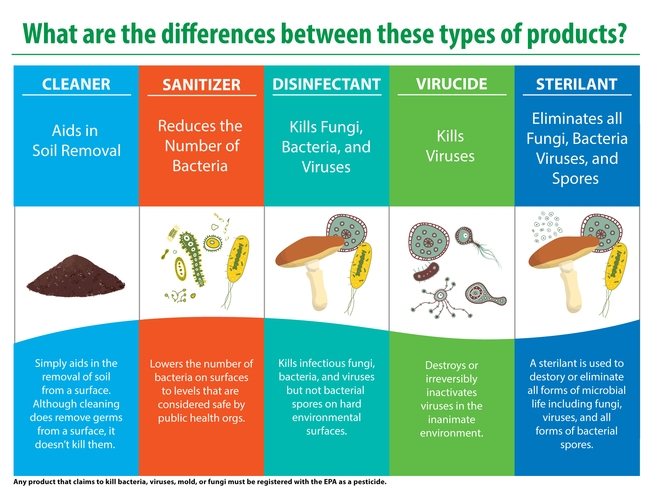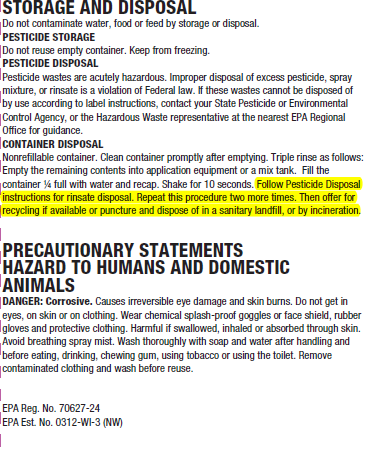What do “pest control” and public health campaigns against SARS Cov-2 have in common? Both activities use pesticides. In the eyes of the law, sanitizer and disinfectant products are considered pesticides. And if you're a little wary of using pesticides, you should exercise the same caution when choosing and using a disinfectant.
Originally posted by Mike Merchant on Insects in the City.
Let's start with some basics. The term ‘pesticide' refers to any substance or mixture of substances used to prevent, destroy, repel or mitigate a pest. All pesticides are regulated by the U.S. Environmental Protection Agency (EPA), which gets to decide if, how and where they can be used.
Antimicrobials include several categories of products. To maintain virus-free surfaces use a disinfectant or a virucide. Sterilants are generally more toxic and reserved for critical environments like hospitals. Infographic courtesy Enviroxyclean.
Pesticides that fight microbes are generally called antimicrobials. Antimicrobials that fight germs affecting human health can be further classified as sanitizers, disinfectants, virucides and sterilants. About 275 active ingredients are found in antimicrobials, most of which are considered pesticides and must have an EPA-approved label (a few sanitizer products–such as alcohol gels–for use on skin are considered drugs rather than pesticides, and are regulated as such by the Food and Drug Administration). Most of the effective products that fight the SARS-CoV-2 virus are considered disinfectants or virucides.
Since January we've watched endless news clips of sanitary workers cleaning surfaces, and even entire buildings, with disinfectants. Shopping for groceries has become an adventure in disinfectant wipes and hand sanitizer. And the empty shelves in the cleaning supply sections of stores attest to our new obsession with clean, clean, clean!
But how many of us stop to consider the health effects of disinfectants, or to read the labels on these products? If you find yourself using disinfectants, or touching disinfectant-treated surfaces, now's an excellent time to brush up on disinfectant safety. Specifically let's review some of the important things we all need to know about reading and understanding disinfectant labels.
There is a lot of information on a disinfectant label. Not reading and following label instructions puts you at risk of breaking federal and state pesticide regulations-not to mention putting your health at risk.
Read the label
- Unlike instructions on a box of mac and cheese, instructions on a disinfectant label are the law, not suggestions. Using even a little more disinfectant than the label allows in a cleaning solution, or failing to wear the proper safety gear specified on the label, to give two examples, is a violation of state and federal pesticide laws.
- Look for an EPA registration number (see label to right). This is a unique number that tells you the product has been reviewed by the EPA and allows you to reference it. For example, the EPA has developed a list of all disinfectants that are believed to be effective against the SARS-CoV-2 virus (List N). If you want to know whether your disinfectant is likely to be effective against coronavirus, you can look it up in this table by its registration number.
- Read the precautionary statements. Precautionary statements include specific requirements on what you must wear when applying the product. If you're an employer or supervisor it's critical you provide training to ensure employees know disinfectant instructions and have the proper safety equipment. In a recent case, employees of a large company were told to switch from mild green-cleaning agents to a powerful disinfectant to deal with the coronavirus emergency. Not used to the new product, janitorial staff became ill and suffered red- itchy skin and burning eyes.
- Pay attention to contact times on the disinfectant label. Many disinfectants must remain wet on surfaces for an extended time (usually 1 to 10 minutes) to effectively kill viruses and bacteria. Don't assume you can immediately wipe down a surface that you treat with a disinfectant.
- When deciding on a safe disinfectant to use in your home or workplace, consider the signal word. The signal word provides a quick reference to the relative hazard associated with using a product. One of three signal words–DANGER, WARNING, or CAUTION must be on the front panel of any disinfectant product. DANGER signals the highest warning. Such products may be highly toxic when ingested, or may induce irreversible eye or skin damage if used without proper protective gear. WARNING labeled products are moderately toxic if ingested or may cause reversible skin or eye irritation. CAUTION labeled products will be the least hazardous, and would be best for home environments, especially where children are present.
- Pay attention to what surfaces the disinfectant is designed to be used on, and what kind of application methods are allowed by the label. If a product is labeled for use on hard, non-porous environmental surfaces, it shouldn't be used on carpet or furniture. Something designed to be applied with a sponge should not be used in a fogger or sprayer.
- Care should be taken with even with the simplest task of removing disinfectant wipes from their plastic tubs. We have reports of people getting disinfectant in their eyes from tiny droplets erupting when towels are pulled too quickly from the container.
Treat all disinfectants with the same respect you would any pesticide. Since coronavirus began its spread, the EPA has been receiving more health-related emergency calls about improper use of disinfectants. One common problem occurs when people use Clorox wipes to wipe their faces–not good. One couple thought they could drink bleach to cure COVID-19. And they are many more cases of people being hurt by mixing chlorine- and ammonia-containing products (resulting in production of the toxic gas, ammonium chloride). None of these are good ideas and none are recommended on the label.
Our office provides training throughout the year to folks in the pest control, public health and outdoor landscape maintenance industries. One of the things we drill into our students is the importance of reading the label for safety and legal purposes. All of us need to exercise the same caution when using disinfectant products. They are, after all, pesticides.
Originally posted by Mike Merchant on Insects in the City.

